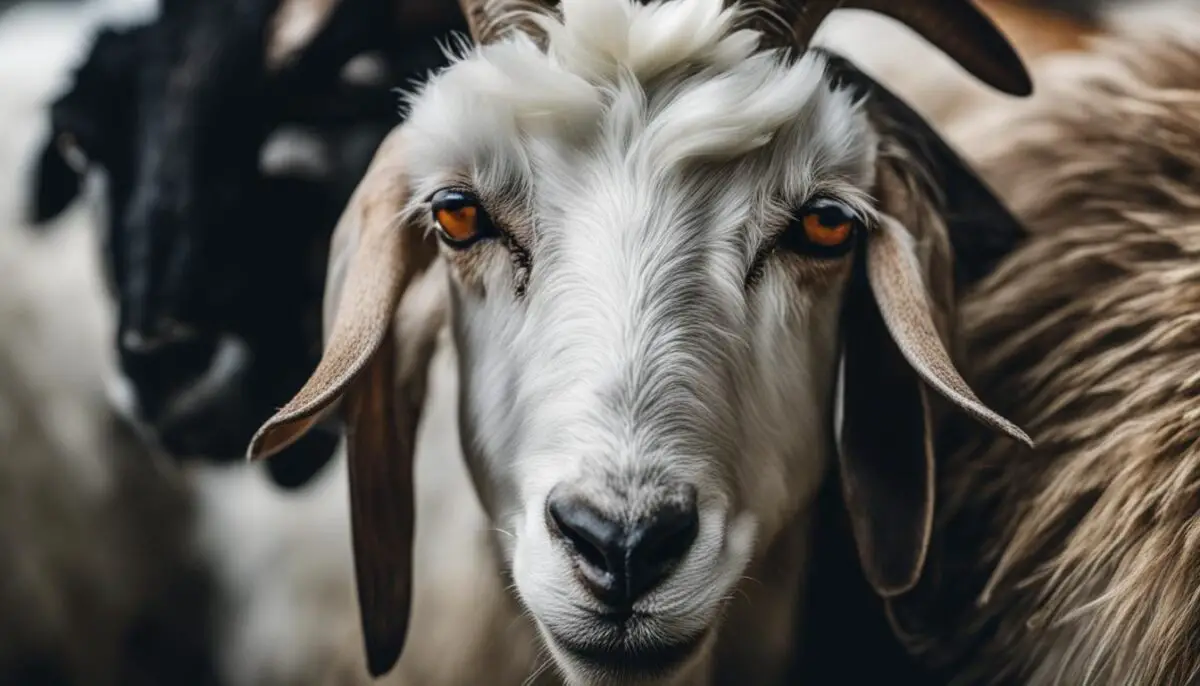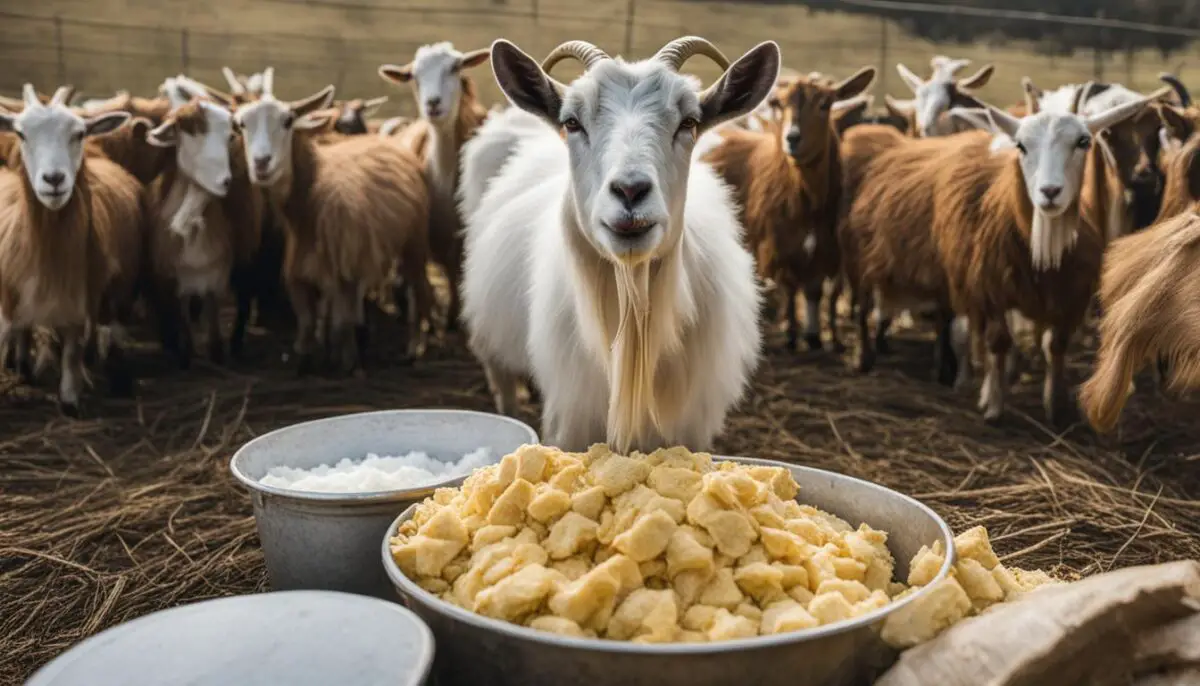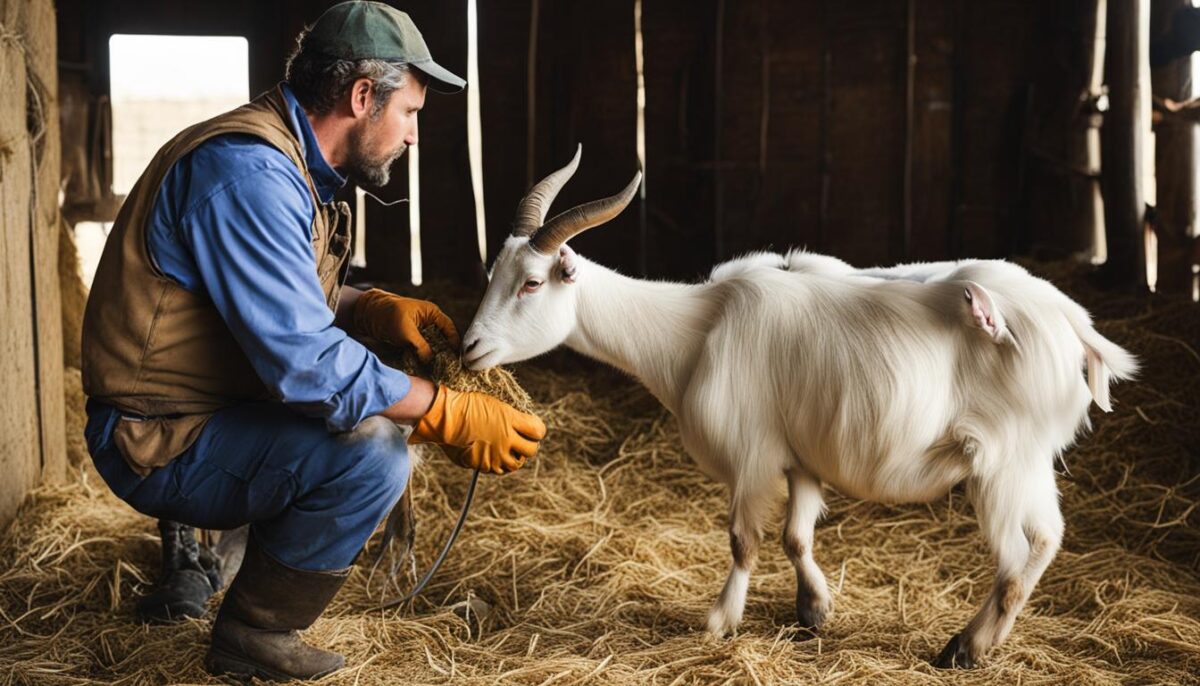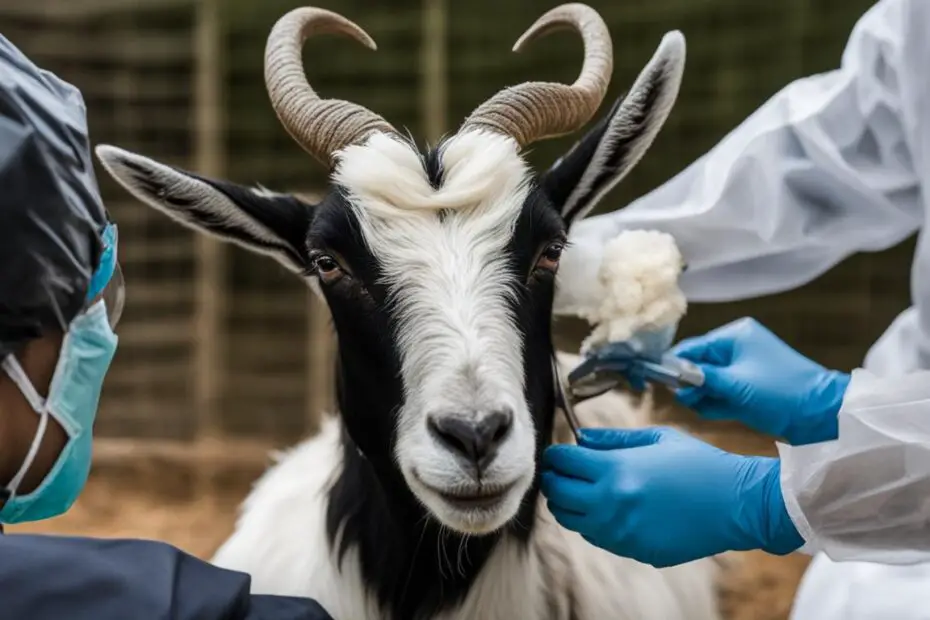Goat foaming at the mouth can be a distressing and potentially life-threatening condition. It is important to understand the causes, symptoms, and treatment options for this condition in order to provide effective care for your goats.
Goat bloat is a common cause of foaming at the mouth. It occurs when there is a buildup of gas in the rumen, leading to bloating and discomfort. Recognizing the signs of goat bloat is crucial for early intervention and treatment.
There are several treatment options for goat foaming at the mouth, including relieving the gas through various methods such as standing the goat with front legs higher than the back or using a stomach tube to release the gas. In severe cases, veterinary assistance may be required to pierce the rumen with a trochar.
Prevention is key to avoiding goat foaming at the mouth. By providing a suitable diet, avoiding overeating, and ensuring access to plenty of forage, you can minimize the risk of this condition in your goats.
Key Takeaways:
- Goat foaming at the mouth can be caused by conditions such as bloat or an obstruction in the throat or esophagus.
- Common symptoms of foaming at the mouth in goats include belching, discomfort, and difficulty breathing.
- Treatment options for goat foaming at the mouth include relieving the gas and seeking veterinary care.
- Prevention involves providing a suitable diet and monitoring goats for any signs of distress.
- Consult with a veterinarian for proper diagnosis and treatment if you suspect your goat is foaming at the mouth.
Causes of Foaming at the Mouth in Goats
Foaming at the mouth in goats can be caused by various factors. One common cause is bloat, which can occur when goats overeat or consume inappropriate food, such as grains or legumes. Another cause may be an obstruction in the throat or esophagus, which prevents the goat from properly releasing gas. Other possible causes include poisoning, excessive salivation, uneven teeth, or organophosphate poisoning. It is important to identify the underlying cause in order to provide appropriate treatment.
Table (Table 2): Causes of Foaming at the Mouth in Goats
| Cause | Description |
|---|---|
| Bloat | Occurs when goats overeat or consume inappropriate food |
| Throat or esophageal obstruction | Prevents proper gas release |
| Poisoning | Ingestion of toxic substances |
| Excessive salivation | Abnormal production of saliva |
| Uneven teeth | Dental issues affecting proper chewing and swallowing |
| Organophosphate poisoning | Ingestion of pesticides or insecticides |
By understanding the various causes of foaming at the mouth in goats, veterinarians and goat owners can effectively diagnose and treat the underlying condition, ensuring the well-being of the animals.
Symptoms of Foaming at the Mouth in Goats
Foaming at the mouth in goats can be a concerning symptom that may indicate an underlying health issue. It is important for goat owners and caretakers to be aware of the symptoms associated with foaming at the mouth to ensure prompt veterinary attention and appropriate treatment. The following are common symptoms that may be observed in goats experiencing foaming at the mouth:
- Grinding teeth: Goats may grind their teeth when they are in discomfort or pain. Grinding teeth can be a sign of foaming at the mouth, indicating the need for veterinary care.
- Drooling: Excessive drooling or salivation may be observed in goats with foaming at the mouth. This can be a result of discomfort or an underlying health issue.
- Frothing at the mouth: Foamy saliva around the mouth is a visible sign of foaming at the mouth in goats. The presence of foam should not be ignored and should prompt further investigation and treatment.
These symptoms may be accompanied by other signs of distress, such as lack of appetite, reduced activity, or changes in behavior. It is important to closely monitor goats and seek veterinary care if any of these symptoms are observed. Timely intervention can help prevent further complications and ensure the well-being of the affected goats.
Example Table:
| Symptom | Description |
|---|---|
| Grinding teeth | Goats grind their teeth when in discomfort or pain. Grinding teeth can be a sign of foaming at the mouth. |
| Drooling | Excessive drooling or salivation may be observed in goats with foaming at the mouth. |
| Frothing at the mouth | Foamy saliva around the mouth is a visible sign of foaming at the mouth in goats. |
It is important to note that these symptoms can indicate various underlying causes, including bloat, poisoning, or other health conditions. Therefore, proper diagnosis by a veterinarian is essential for appropriate treatment. Goat owners should consult with a veterinarian if they notice any of these symptoms or have concerns about the health of their goats.

Treatment for Goat Foaming at the Mouth
When it comes to treating a goat foaming at the mouth, prompt action is crucial. The specific treatment will depend on the underlying cause of the foaming. If the goat is experiencing bloat, immediate measures should be taken to relieve the gas and alleviate the symptoms. One method is to stand the goat with its front legs higher than its back, which can help release the gas. Another option is to use a stomach tube to directly release the gas from the rumen. In severe cases, under veterinary supervision, piercing the rumen with a trochar may be necessary.
In addition to gas relief methods, there are other treatment options available. Antifoaming agents can be used to decrease the amount of foam in the rumen, helping to alleviate the symptoms. Specialized goat bloat medicine prescribed by a veterinarian may also be given to address the underlying cause and provide relief. It is important to consult with a veterinarian for a proper diagnosis and to discuss the most appropriate treatment plan for the specific situation.
Remember, veterinary care is essential when dealing with a goat foaming at the mouth. A veterinarian will be able to accurately diagnose the underlying cause and recommend the most effective treatment options. Do not attempt to administer any medications or treatments without proper guidance from a professional. Timely intervention can greatly improve the goat’s chances of a successful recovery and prevent further complications.
Preventing Foaming at the Mouth in Goats
Preventing foaming at the mouth in goats is essential for their overall health and well-being. By taking proactive measures, you can minimize the risk of this condition and ensure the well-being of your goats. Here are some key strategies to prevent foaming at the mouth:
- Provide a suitable diet: A balanced diet is crucial for preventing foaming at the mouth in goats. Ensure that their diet consists of at least 75% long-fiber vegetation, such as hay or pasture. Avoid feeding them large amounts of rich feed that they are unaccustomed to, as this can contribute to bloat.
- Manage feed intake: It is important to monitor the amount and type of feed your goats consume. Avoid overfeeding and provide small quantities of grains or concentrates if necessary. Introduce new foods gradually to prevent digestive upsets.
- Create a safe environment: Goats should have access to fresh water at all times. Make sure their living area is clean and free from any potential hazards or toxic plants that could cause foaming at the mouth. Regularly inspect their surroundings and remove any potential choking hazards.
- Regular veterinary care: Schedule regular check-ups with a veterinarian to monitor the health of your goats. They can provide guidance on proper nutrition, identify any underlying health issues, and recommend preventive measures specific to your goats’ needs.
By following these preventive measures, you can significantly reduce the risk of foaming at the mouth in goats. However, it is important to keep in mind that each goat is unique, and their dietary and healthcare needs may vary. Consulting with a veterinarian is always advisable to ensure the best care for your goats.
Table: Tips for Preventing Foaming at the Mouth in Goats
| Preventive Measures | Description |
|---|---|
| Provide a suitable diet | Ensure at least 75% long-fiber vegetation in their diet, such as hay or pasture. |
| Manage feed intake | Monitor the amount and type of feed, avoid overfeeding, and introduce new foods gradually. |
| Create a safe environment | Ensure access to fresh water, remove potential hazards or toxic plants, and inspect surroundings regularly. |
| Regular veterinary care | Schedule check-ups to monitor health, receive guidance on proper nutrition, and address any underlying issues. |
Types of Foaming at the Mouth in Goats
When it comes to foaming at the mouth in goats, there are different types of situations that can occur. Two common types are frothy bloat and choking or free gas bloat. Understanding these different types can help in providing appropriate treatment and care for affected goats.
Frothy Bloat
Frothy bloat happens when overactive microbes in the rumen produce a foamy slime that coats the gas, effectively sealing it in the rumen. This can occur when goats consume large amounts of rich food that they are unaccustomed to. The foam prevents the gas from being released, leading to bloating and discomfort for the goat.
Frothy bloat can be a serious condition that requires prompt attention. It is important to identify the underlying cause, which is often related to diet, and take appropriate measures to relieve the bloating and address the root issue.
Choking and Free Gas Bloat
Choking or free gas bloat occurs when there is an obstruction in the throat or esophagus, preventing the goat from properly releasing gas. This obstruction can be caused by the goat consuming chunks of food that become stuck or other types of obstructions.
Choking or free gas bloat can be a life-threatening condition if not addressed promptly. It is crucial to recognize the symptoms and seek veterinary care to help remove the obstruction and alleviate the goat’s discomfort.
| Type of Foaming at the Mouth | Cause | Treatment |
|---|---|---|
| Frothy Bloat | Overactive microbes in the rumen produce a foamy slime that coats the gas | Relieve the bloating and address the underlying cause through appropriate dietary adjustments and veterinary care |
| Choking and Free Gas Bloat | Obstruction in the throat or esophagus prevents gas from being released | Seek veterinary care to remove the obstruction and provide relief for the goat |
Understanding the different types of foaming at the mouth in goats is essential for effective treatment and care. By recognizing the symptoms and identifying the underlying cause, appropriate measures can be taken to help goats recover and prevent future occurrences of foaming at the mouth.

Complications of Foaming at the Mouth in Goats:
| Complication | Symptoms |
|---|---|
| Indigestion | Poor appetite, reduced feed intake, discomfort, decreased milk production |
| Acidosis | Diarrhea, dehydration, lameness, depression, increased heart rate |
| Polioencephalomalacia | Blindness, head pressing, seizures, lack of coordination |
| Enterotoxemia (Overeating Disease) | Diarrhea, abdominal pain, sudden death |
| Founder (Laminitis) | Lameness, heat in hooves, increased digital pulses, reluctance to move |
Recognizing and Detecting Goat Bloat
Recognizing and detecting goat bloat is essential for early intervention and treatment. By promptly identifying the symptoms, goat owners can take immediate action to relieve the bloating and prevent further complications. The key to recognizing goat bloat is closely observing the physical signs and behavioral changes in the affected goats.
One of the most noticeable signs of goat bloat is the distention and enlargement of the rumen, which creates a large bulge on the left side of the goat’s abdomen. This is often accompanied by dyspnea, grunting, and mouth breathing as the goat tries to cope with the discomfort. Other symptoms may include protrusion of the tongue, frequent urination, and changes in behavior or posture.
It is important to note that goat bloat can progress rapidly and become life-threatening if left untreated. Therefore, if any symptoms of goat bloat are observed, immediate veterinary attention should be sought. Early diagnosis and intervention can greatly improve the chances of successful treatment and recovery for the affected goat.

| Recognizing Goat Bloat |
|---|
| Distention and enlargement of the rumen |
| Large bulge on the left side of the abdomen |
| Dyspnea, grunting, and mouth breathing |
| Protrusion of the tongue |
| Frequent urination |
| Changes in behavior or posture |
Treatment Options for Goat Bloat
When it comes to treating goat bloat, there are several options available depending on the severity of the condition. The goal is to relieve the gas buildup in the rumen and alleviate the symptoms to prevent further complications. Emergency goat bloat treatment may require more invasive procedures, while mild cases can often be managed with less invasive methods.
Invasive Procedures:
If the goat’s condition is severe and requires immediate intervention, a veterinarian may perform a rumenotomy. This procedure involves surgically opening the rumen to release the trapped gas and remove any ruminal material. While this is considered a more invasive option, it can be life-saving for a severely bloated goat.
Less Invasive Methods:
- Standing with Front Legs Higher: This method involves positioning the goat with its front legs elevated, allowing the gas to rise and be released. This can be done by placing the goat on an incline or using a milking stand with the front end raised.
- Stomach Tube: Inserting a stomach tube into the goat’s rumen can help release the trapped gas. The tube is carefully inserted through the mouth or nostril and down into the rumen, allowing the gas to escape.
- Rumen Puncture: Piercing the rumen with a trochar under veterinary supervision can be a last resort for severe cases. This procedure should only be performed by a professional to avoid further complications.

It is crucial to consult with a veterinarian for proper diagnosis and treatment. They will be able to assess the severity of the goat’s bloat and recommend the most appropriate treatment option. Early intervention is key to increasing the chances of a successful outcome and preventing further complications.
Conclusion
Effective treatment and prevention strategies for goat foaming at the mouth and bloat are crucial for the health and well-being of goats. By recognizing the symptoms and understanding the underlying causes, goat owners can take prompt action to provide the necessary care.
Prevention plays a key role in minimizing the risk of goat foaming at the mouth. It starts with providing goats with a suitable diet, including high-quality forage and gradually introducing grains or concentrates. Avoiding overeating and ensuring access to fresh water are also important.
Timely veterinary care is essential in case of any concerns or symptoms. Consulting with a veterinarian for proper diagnosis and treatment options is highly recommended. With the right knowledge and proactive management, goat foaming at the mouth and bloat can be effectively addressed, promoting the overall health and well-being of these animals.
FAQ
What are the symptoms of goat bloat?
Symptoms of goat bloat include belching, belly rumbling, chewing the cud, lack of appetite, discomfort, abdominal inflation, pain, grinding teeth, frequent urination, and difficulty breathing.
What are the treatment options for goat bloat?
Treatment options for goat bloat include relieving the gas through methods such as standing the goat with front legs higher than the back, using a stomach tube to release the gas, or in severe cases, piercing the rumen with a trochar under veterinary supervision.
How can foaming at the mouth in goats be prevented?
Foaming at the mouth in goats can be prevented by providing a suitable diet, avoiding overeating, and ensuring goats have access to plenty of forage.
What are the different types of foaming at the mouth in goats?
There are different types of foaming at the mouth in goats, including frothy bloat and choking or free gas bloat.
What complications can foaming at the mouth in goats lead to?
Foaming at the mouth in goats can lead to complications such as indigestion, acidosis, and other digestive disorders.
How can goat bloat be recognized and detected?
Goat bloat can be recognized by observing the distention and enlargement of the rumen, which creates a large bulge on the left side of the goat’s abdomen.
What are the treatment options for goat bloat?
Treatment options for goat bloat include relieving the gas through various methods such as standing the goat with front legs higher than the back, using a stomach tube to release the gas, or in severe cases, piercing the rumen with a trochar under veterinary supervision.
How can foaming at the mouth in goats be prevented?
Foaming at the mouth in goats can be prevented by providing a suitable diet and creating a safe environment for the animals.
What are the different types of foaming at the mouth in goats?
There are different types of foaming at the mouth in goats, including frothy bloat and choking or free gas bloat.
What complications can foaming at the mouth in goats lead to?
Foaming at the mouth in goats can lead to complications such as indigestion, acidosis, and other digestive disorders.
How can goat bloat be recognized and detected?
Goat bloat can be recognized by observing the distention and enlargement of the rumen, which creates a large bulge on the left side of the goat’s abdomen.
What are the treatment options for goat bloat?
Treatment options for goat bloat include relieving the gas through various methods such as standing the goat with front legs higher than the back, using a stomach tube to release the gas, or in severe cases, piercing the rumen with a trochar under veterinary supervision.
How can foaming at the mouth in goats be prevented?
Foaming at the mouth in goats can be prevented by providing a suitable diet and creating a safe environment for the animals.
What are the different types of foaming at the mouth in goats?
There are different types of foaming at the mouth in goats, including frothy bloat and choking or free gas bloat.
What complications can foaming at the mouth in goats lead to?
Foaming at the mouth in goats can lead to complications such as indigestion, acidosis, and other digestive disorders.
How can goat bloat be recognized and detected?
Goat bloat can be recognized by observing the distention and enlargement of the rumen, which creates a large bulge on the left side of the goat’s abdomen.
What are the treatment options for goat bloat?
Treatment options for goat bloat include relieving the gas through various methods such as standing the goat with front legs higher than the back, using a stomach tube to release the gas, or in severe cases, piercing the rumen with a trochar under veterinary supervision.
How can foaming at the mouth in goats be prevented?
Foaming at the mouth in goats can be prevented by providing a suitable diet and creating a safe environment for the animals.
What are the different types of foaming at the mouth in goats?
There are different types of foaming at the mouth in goats, including frothy bloat and choking or free gas bloat.
What complications can foaming at the mouth in goats lead to?
Foaming at the mouth in goats can lead to complications such as indigestion, acidosis, and other digestive disorders.
How can goat bloat be recognized and detected?
Goat bloat can be recognized by observing the distention and enlargement of the rumen, which creates a large bulge on the left side of the goat’s abdomen.
What are the treatment options for goat bloat?
Treatment options for goat bloat include relieving the gas through various methods such as standing the goat with front legs higher than the back, using a stomach tube to release the gas, or in severe cases, piercing the rumen with a trochar under veterinary supervision.
How can foaming at the mouth in goats be prevented?
Foaming at the mouth in goats can be prevented by providing a suitable diet and creating a safe environment for the animals.
What are the different types of foaming at the mouth in goats?
There are different types of foaming at the mouth in goats, including frothy bloat and choking or free gas bloat.
What complications can foaming at the mouth in goats lead to?
Foaming at the mouth in goats can lead to complications such as indigestion, acidosis, and other digestive disorders.
How can goat bloat be recognized and detected?
Goat bloat can be recognized by observing the distention and enlargement of the rumen, which creates a large bulge on the left side of the goat’s abdomen.
What are the treatment options for goat bloat?
Treatment options for goat bloat include relieving the gas through various methods such as standing the goat with front legs higher than the back, using a stomach tube to release the gas, or in severe cases, piercing the rumen with a trochar under veterinary supervision.


